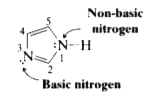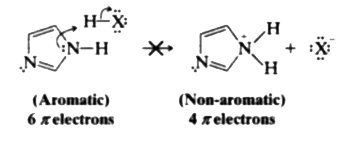Imidazole (at right) has two nitrogens, N3 is relatively basic (like the nitroge of pyridine). N1 is relatively non-basic (like the nitrogen of pyrrole). Explain the different basicities of these two nitrogens.

When imidazole accepts a proton at N3 the electron pair that accepts the proton is not a part of the system of six electrons that makes imidazole aromatic. Consequently, the conjugate base that is formed is still aromatic (it is an aromatic cation) and retains its resonance energy of stabilization.

On the other hand, if imidazole were to accept a proton at N1 the resulting ion (which is not formed) would not be aromatic and would have much greater potential energy (its resonance stabilization would be lost). Hence, N1 is not appreciably basic.

Related Playlists
- BOOK - MS CHOUHANCHAPTER - AROMATIC COMPOUNDSEXERCISE - Additional Objective Questions (Single Correct Choice Type)20videos
AROMATIC COMPOUNDS
- BOOK - MS CHOUHANCHAPTER - AROMATIC COMPOUNDSEXERCISE - Additional Objective Questions (Linked Comprehension Type)6videos
AROMATIC COMPOUNDS
- BOOK - MS CHOUHANCHAPTER - AROMATIC COMPOUNDSEXERCISE - Subjective Problems3videos
AROMATIC COMPOUNDS
- BOOK - MS CHOUHANCHAPTER - AN INTRODUCTION TO ORGANIC REACTIONS AND THEIR MECHANISMS ACIDS AND BASESEXERCISE - ADDITIONAL QUESTION (SINGLE CORRECT CHOICE TYPE )32videos
AN INTRODUCTION TO ORGANIC REACTIONS AND THEIR MECHANISMS ACIDS AND BASES
- BOOK - MS CHOUHANCHAPTER - BIOMOLECULESEXERCISE - Level 21videos
BIOMOLECULES
Similar Questions
Nitrogen (N2) is relatively unreactive, because
View SolutionDNA and RNA are the information molecules of the cell. Explain clearly the differences in the basic structure of these two molecules.
View SolutionA: Pyrrole is less basic than pyridine.
R: Lone pair electron of nitrogen in pyrrole participate in conjugation to gain aromatic character.View SolutionA: Pyrrole is less basic than pyridine.
R: Lone pair electron of nitrogen in pyrrole participate in conjugation to gain aromatic character.View SolutionWhich N of guanidine (I) is more basic and is more likely to be protonated ?
View SolutionThe lone pair of amines makes them basic. They react with acids to form acid-base salts. Amines are more basic than alcohols, ethers and water. When an amine is dissolved in water, an equilibrium is established , where water acts as an acid and transfer a proton to the amine. The basic strength of an amine can be measured by basicity constant Kb.
Arylamines are less basic than alkylamines because the lone pair of nitrogen is delocalised with the aromatic ring and are less available for donation.
Substituted arylamines can be either more basic or less basic than aniline , depending on the substituted . ERG substituents, such as −CH3,−NH2and−OCH3 increases the basicity and EWG substituents , such as −Cl,−NO2and−CN decreases basicity. While sp2− hybridized nitrogen atom in pyridine is less basic then the sp3 -hybridized nitrogen in an alkylamine.
The most basic carbanion is :View SolutionThe lone pair of amines makes them basic. They react with acids to form acid-base salts. Amines are more basic than alcohols, ethers and water. When an amine is dissolved in water, an equilibrium is established , where water acts as an acid and transfer a proton to the amine. The basic strength of an amine can be measured by basicity constant Kb.
Arylamines are less basic than alkylamines because the lone pair of nitrogen is delocalised with the aromatic ring and are less available for donation.
Substituted arylamines can be either more basic or less basic than aniline , depending on the substituted . ERG substituents, such as −CH3,−NH2and−OCH3 increases the basicity and EWG substituents , such as −Cl,−NO2and−CN decreases basicity. While sp2− hybridized nitrogen atom in pyridine is less basic then the sp3 -hybridized nitrogen in an alkylamine.
The most basic carbanion is :View Solution(A) Pyrrole is more basic than pyridine.
(R) In pyrrole, nitrogen is sp2-hybridized.View SolutionHigh basicity of Me2NH relative to Me3N is attributed to :
View SolutionHigh basicity of Me2NH relative to Me3N is attributed to :
View Solution

